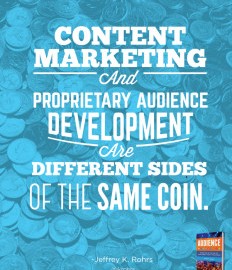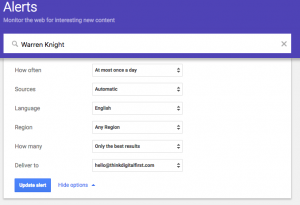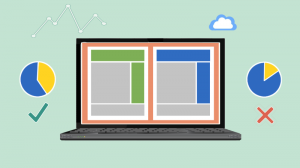How do you build an audience on social media? I recently had a chat with Jeff Rohrs, VP, Marketing Insights at Salesforce and author of Audience: Marketing in the Age of Subscribers, Fans & Followers. Have a listen to the audio podcast above or keep reading for an abridged transcript of our conversation. Questions by me, answers by Jeff.
What is the value of a social audience and how can you measure it?
The value just of an audience is that you have an exclusive right to communicate with a group of folks who’ve given you permission to do so. That’s true whether you’re a marketer or whether you’re a performer or a preacher or a politician. What social media and the web and the era of mobile devices have given brands is the ability to speak to these consumers who are hand raisers.
And so it’s a little bit of a different way of thinking of social media in terms of outcome and in terms of assets because audiences are assets. They have true monetary value. There’s a reason we pay for advertising because we are relying on third parties to give us that access. We’re willing to pay for that access. But when you build social audiences that are direct, now you’ve eliminated the third party cost. And the value of it can be calculated innumerable ways. And right now it’s somewhat an imprecise science in many of the channels because it’s very difficult to track back precise value and influence. Ultimately in the mobile and social era, there are multiple contributing factors that influence purchase decisions. But if we if we look at the audience you’re building, and first and foremost trying to describe a individual value to that, we could do that perhaps based on lifetime customer value which is kind of the holy grail of understanding what is a customer worth to us.
PR folks look at media equivalency value. What would have been the cost to get that kind of exposure to that size of an audience through a paid third party channel? And then they’ll ascribe that to the value that they’ve created through whatever social or direct channel. So maybe to sum it up, the audience value really is that ability to speak direct to the consumer so that you can reduce your dependency on paid media and ultimately increase the speed with which you can go to market with new ideas, new products or hopefully increase social amplification.
Is an email address worth more than a social follow?
 I think you have to look at your industry. You have to look at your target market and your target consumer and see what channels they ultimately use when interacting. Don’t make assumptions. I think a lot of folks over the last few years have made assumptions that younger consumers aren’t using e-mail, or they aren’t doing as or they’re doing that. And they aren’t actually looking at how their consumers are behaving. They’re just reading headlines or research studies that are done on samples that are rather small. My advice to brands is talk to your consumers. Observe them in the wild. If you have a retail space, watch what they do. See what they respond to. For the most part, I see the majority of companies emphasising email and getting a very large return on that channel because of the control that they can exercise and the personalisation that they can offer. You know when you get that email address it becomes that foundation around which you can build a single view of that consumer that doesn’t just help you in the email channel, it helps you online through personalisation. It helps you in social and social advertising targeting and personalisation because there’s an interesting hybridisation happening in that realm between e-mail and social as well.
I think you have to look at your industry. You have to look at your target market and your target consumer and see what channels they ultimately use when interacting. Don’t make assumptions. I think a lot of folks over the last few years have made assumptions that younger consumers aren’t using e-mail, or they aren’t doing as or they’re doing that. And they aren’t actually looking at how their consumers are behaving. They’re just reading headlines or research studies that are done on samples that are rather small. My advice to brands is talk to your consumers. Observe them in the wild. If you have a retail space, watch what they do. See what they respond to. For the most part, I see the majority of companies emphasising email and getting a very large return on that channel because of the control that they can exercise and the personalisation that they can offer. You know when you get that email address it becomes that foundation around which you can build a single view of that consumer that doesn’t just help you in the email channel, it helps you online through personalisation. It helps you in social and social advertising targeting and personalisation because there’s an interesting hybridisation happening in that realm between e-mail and social as well.
What challenges do companies face with audience building?
There are numerous challenges. First of all, not thinking of yourself as a media company and somebody who builds audiences instead of just thinking of channels that you execute against. That’s the message of my book Audience is that we’ve got to be thinking about audience as this permanent asset that we’re building. And that means we’ve got to have a person or a group of people who are thinking horizontally across the organisation and strategically, not just channel specific. What audience should we be building and how do we increase over time the size, the engagement, and the value of that audience? Because it’s not something that you just build and you’re done; you have to continue to build your audience.
For those who’ve read the book or see me speak, I’m a big fan of Premier League football. You know I follow Tottenham Hotspur, and you know the other big story last year was Manchester United’s fall from grace. You look at Manchester United. That’s one of, if not the biggest club in the world but they are constantly working through sponsorship and advertising to gain new fans around the world. They’re constantly working on that so that the next tour that they have to Asia, there are more people in the stands, more people watching their games on television so that the value of the brand increases. So I want all brands to think like that. I want them to understand; now, because of instantaneous worldwide distribution, you have an audience you can take and bring with you and grow over a period of time. It’s not something that you just do when you need it. It is very much an effort you have to have continuously going on. So another way to look at it is the content marketing world is exploding right now, and content is a great way to attract an audience. But if that content attracts an audience and you don’t have a capture mechanism to ask for the email address or to get that folks to engage with you on one of the social channels or like you or follow you or what have you, you’re reinventing the wheel the next time you go out with that content. And it means you’re going to have to pay for advertising to promote that content.
How do you segment audiences?
 I was going to write a book based on our research series that we’ve done called Subscribers, Fans, and Followers. And as I looked at that I realized, was a subset of a much larger audience discussion. And if you look at the three broad categories, there are seekers, there are amplifiers and there are joiners.
I was going to write a book based on our research series that we’ve done called Subscribers, Fans, and Followers. And as I looked at that I realized, was a subset of a much larger audience discussion. And if you look at the three broad categories, there are seekers, there are amplifiers and there are joiners.
The seekers are the people who may or may not have a brand affiliation with you, but they’re out there looking for information or entertainment. And so they have kind of an instantaneous need, and when they fulfill it, they’re there and gone. And so seekers we’re most often attracting through search engine marketing, through paid advertising. And as we think about that audience, our objective has to be how do I capture that instant attention and convert it into another audience with which I can have more interaction, more permanent interaction? And again, I can convert them into a customer, customer being the ultimate form of audience. So the seeker is temporal; we get them through advertising, search engine optimization, etc.
Over in the middle there’s this group I call amplifiers, and those are the folks that we think of most often with social media. But if you look at that group, it used to be the folks that just PR dealt with, right? The analysts, the influencers, the press. But now everybody is an influencer. Everybody has a social network, whether it’s just by word of mouth or it’s their Facebook fans, their Twitter followers, etc. So when you look at amplifiers, this is somebody who’s looking for influence or access to information so that they can then publish out to their network, to their audience. And gain some sort of prestige, gain some sort of value because they’re providing valuable information or something that’s funny or something that just kind of amuses people. But the bottom line is the amplifiers are audiences with audiences. And again, if you look at that group, they’re temporal. Once they amplify, they’re there and gone. And so, yes it’s wonderful to get that amplification but again I want to graduate them into kind of the third group.
Joiners is where I have got the ability to open message them directly. Again, the ultimate joiner being a consumer. They join with their wallet. And short of that, short of getting the actual customer the purchaser, I perhaps want to get them as a subscriber, fan, or follower. Those are a subset of the joiners. And subscribers, most often you think of email but also text messaging. The fans, you most often think of Facebook. And with followers, you most often think of Twitter. But we all know that there are other channels out there. Like a subscription channel that is tremendously valuable right now is YouTube. Because those subscribers get notified either in their stream or via emails from YouTube when you post new videos. And you’re seeing brands and individuals have tremendous success building a subscription, a subscriber base. There are a group of joiners. And joiners, what they want is they want the information that’s promised to them when they sign up, sent through the channel they request. And so there’s this kind of closer proximity there and a continuous ongoing form of communication that is not present with seekers and with amplifiers. But with all three of these groups, they’re not mutually exclusive. I can be a member of all three of those audiences for a particular brand.
Top 3 tips to build a social media audience?
 First of all is to optimize your paid media. Most companies are already doing some form of advertising, and most are thinking it’s enough to brand or just try and sell in the moment. We’re asking too little of our paid media in many instances. It can also capture the audience for us. And by that I mean to say, boy, if you’ve got a thirty-second commercial, don’t just slap up a Facebook logo or a Twitter logo. That’s advertising for them. Actually integrate into the creative some sort of interaction that gets them to pick up the mobile phone or to go online and register for e-mail. And again, this takes collaboration with the brand side. And this is where the tension is right now in a lot of those organisations because brand wants to use beautiful campaigns, and the digital direct folks want to build audience. And we haven’t really had those two groups get together and understand they’re not mutually exclusive, they can work together.
First of all is to optimize your paid media. Most companies are already doing some form of advertising, and most are thinking it’s enough to brand or just try and sell in the moment. We’re asking too little of our paid media in many instances. It can also capture the audience for us. And by that I mean to say, boy, if you’ve got a thirty-second commercial, don’t just slap up a Facebook logo or a Twitter logo. That’s advertising for them. Actually integrate into the creative some sort of interaction that gets them to pick up the mobile phone or to go online and register for e-mail. And again, this takes collaboration with the brand side. And this is where the tension is right now in a lot of those organisations because brand wants to use beautiful campaigns, and the digital direct folks want to build audience. And we haven’t really had those two groups get together and understand they’re not mutually exclusive, they can work together.
Second is don’t forget mobile. The vast majority of consumers today, now have mobile devices that basically allow for direct response if only you ask them to do something. And that’s why it’s interesting to me to see so many ads and other things that never have a call to action. When, in fact, if the ad captures a person’s attention and they have interest, give them a way to interact. And that becomes a way that you can get them to subscribe via SMS or scan something or take some step that will actually get them into one of those permission based audience channels.
And I think the third one is to look at what’s happening in the hybridization of social advertising and e-mail and online. Really interesting things happening there as social media comes of age. For instance, you’ve got the custom audiences products from Facebook, which allows you to map your e-mail subscribers to your Facebook fans. And what that allows you to do is a number of things. I can now go in, and I can target advertising to the people who are my Facebook fans but aren’t email subscribers. And what kind of ad would I want to put to them? I probably want to incentivise becoming an e-mail subscriber. Because being a Facebook fan is great but we all know as Facebook has grown in popularity, the distribution of our organic posts has dropped. And so to get that Facebook fan to be an e-mail subscriber gives you control of the cadence, gives you another channel, so that you can diversify and you can have multiple points of contact with that consumer.
(289)








